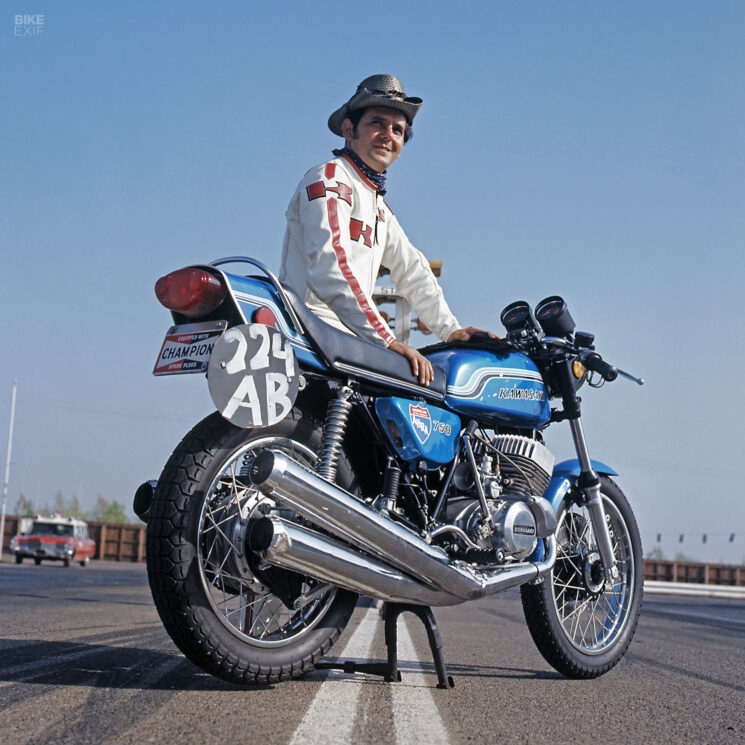
In relative terms, it wasn’t so long ago that it was somewhat rare to see motorcycles on the highways and byways of middle America. Mostly, they were quirky oil-dripping British bikes or nefarious “love ’em or hate ’em” Harley-Davidsons. The truth is, 1960s America was car crazy. Even 16-year-old kids could afford cars and gas was practically free.

The tide began to turn, however, in the late ’60s when the avalanche of Japanese manufacturing technology hit America’s shores. Baby boomers had suddenly become a major purchasing force and motor vehicles evolved from practical and utilitarian to fun and exciting. In motorcycle terms, we all know what happened: four-cylinder overhead cam bikes from Honda suddenly became the new world standard for performance and reliability. And it soon became apparent that Honda wasn’t going to be the only player. Other manufacturers threw their hats into the ring, re-purposing aircraft and military manufacturing facilities to help quench America’s thirst for speed, fun, and adventure.
While Honda promised to provide the impossible trifecta of speed, affordability and reliability, it became evident that the brand was going to be built on the latter. Kawasaki, on the other hand, put speed at the top of its list. American teens drooled over big block Chevys, side-oiler Fords and Hemi Mopars; Kawasaki wanted to provide the two-wheeled adrenaline machines to scratch that particular itch. This corporate goal saw the launch of the N100 Plan:

The goal of Kawasaki engineering in the N100 Plan was to create a large-bore, fast motorcycle engine for entry into the American market, the largest market for motorcycles. Honda had already introduced its successful Honda CB450 in 1965 and Kawasaki desired to enter that large bore niche.
The N100 Plan called for an air-cooled standard motorcycle with an engine capacity of 500 cubic centimeters. The power output was set at no less than 60 ps (equivalent to a per liter horsepower of 120 ps). The performance minimum was to make a 13-second standing start 1/4 mile run (0-400 meters) (Wikipedia)

The bikes born out of the N100 Plan live on today in the hands of collectors, enthusiasts and 50-somethings reliving the days of their youth. The leading force behind the cult following of the Kawasaki triple motorcycles is Rick Brett, an Englishman who now calls northern Michigan home.
Among Rick’s extensive collection of triple memorabilia were original rolls of 21/4″ color transparencies taken in 1972, featuring a gentleman named Tony Nicosia aboard an early H2 750 at Orange County International Raceway in California. Rick had purchased the film directly from Tony and it was reasonably apparent that the images had never been published. This was a found treasure for the Kawasaki triple and motorcycle community alike.

The success of the N100 Plan heavily revolved around Tony Nicosia, the diminutive ex-USAF serviceman who found himself in Japan in the early ’60s and was spending a lot of time at local racetracks and drag strips. At 5’5″ and 102 lbs, Tony was the perfect specimen for motorcycle drag racing. Add to that a penchant for speed, superb engine-building skills and the heart of a lion, and Kawasaki had their quarterback for N100. By the time he retired from Kawasaki in 1973, Tony had set some 120 drag racing records and the Kawasaki brand had become synonymous with speed—a mantle it continues to wear to this day.

In a somewhat theatrical live demonstration in 1969, Kawasaki technicians uncrated and assembled a brand-new three-cylinder H1 two-stroke 500 cc bike at Lion’s Drag strip in southern California. The press watched with bated breath as fluids were added; with a prod of the kicker, the beast crackled to life. Tony Nicosia piloted the machine to a 12.96 quarter mile at over 100 mph, and the 500 triple was officially the fastest production motorcycle on the planet.
Three years later, on March 11, 1972, Tony Nicosia, riding the H2, a 750 two-stroke triple, set a production bike quarter mile record of 11.95 seconds at 115.38 mph at Fremont Dragstrip in California.

Although the Kawasaki brand has remained at the top of the performance charts for nearly five decades, names like Tony Nicosia and those incredible records set on America’s drag strips of the ’60s and ’70s have slowly faded from memory.
It’s a good thing we have photos to remind us.

This article first appeared in issue 024 of Iron & Air Magazine, and is reproduced here under license.
Words by Ian Budge | Images Courtesy of Rick Brett
Sidecar Subject: 1969 Kawasaki 500 H1Engine and Performance:
Handling and Riding Experience:
Historical Impact:
Specification:
|
from Bike EXIF https://ift.tt/XfWetTs
No comments:
Post a Comment